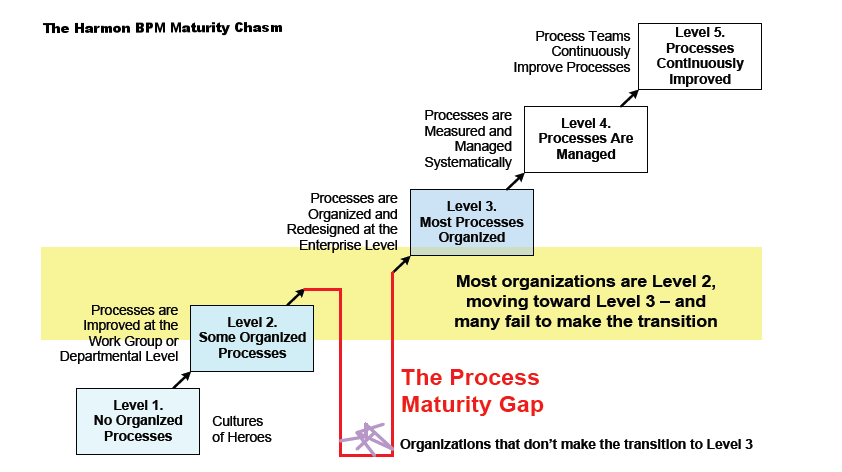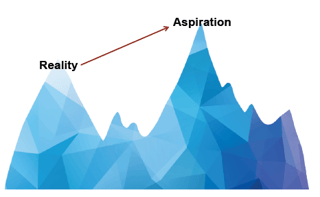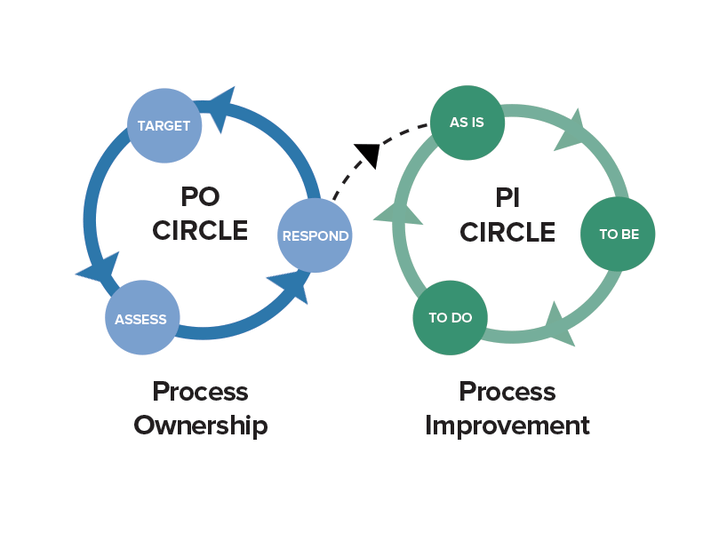Drawing on the lifecycle chasm concept first made popular by Geoffrey Moore (1), Paul Harmon has spoken of a BPM maturity development chasm (2), as shown below. Surveys of BPM Maturity, including the biennial review by BPTrends (3) , show that most organizations that are undertaking some form of process improvement and management are between levels 2 and 3, with many never crossing the chasm to level 3. This is a serious problem because the significant, whole-of-organization benefits are realized at level 3 and above.

Fig 1: The Harmon BPM Maturity Chasm
Most illustrations of the five-step maturity model imply a linear progression from level to level. This is misleading. The biggest step change is from level 2 to level 3. As Paul Harmon eloquently, if graphically, suggests, many don’t make it across the chasm and face a difficult, perhaps impossible, climb to recover.
“We might say that the level 2 team gets up a lot of momentum and then runs and jumps... but it’s in the nature of things that they can never jump completely across the gap, and they hit the wall and slide into the gap – and then crawl out again on the level 2 side. There needs to be a senior executive on the level 3 side of the gap to reach out and give them a hand and pull them up. (4)”
At level 2, an organization has a growing acceptance of the importance of processes, some processes have been documented, and process improvement projects are becoming more common, but the process improvement scope is still quite limited and process work itself remains largely siloed. This level of BPM maturity is comparatively easy to achieve.
To achieve and sustain level 3 requires important differences. The key change is that an enterprise process architecture has been developed and is in common use to guide management decisions, and process improvement and management. Process performance begins to be monitored and any anomalies are detected and addressed resulting in proven beneficial business outcomes. Based on a thorough understanding of the process and its operational context, opportunities for small and large improvement can also be sought quite separate to solving performance problems. This makes the process view and resulting activities a strategic, as well as operational, imperative. At BPM maturity level 3, the organization is showing signs of a genuine process-aware culture.
For most organizations there is a significant gap between their aspirations for higher levels of BPM maturity and the lived reality. This is not to say that crossing the chasm is too hard or too dangerous to be attempted. The lesson is that to be successful organizations need to understand what is involved and prepare properly for the crossing.
Crossing the Chasm – 2 Virtuous Circles
To their significant benefit, many organizations cross the chasm. In the latest published data from the BPTrends State of BPM Survey(5), about 38% of respondents are at levels 3-5 with approximately 60% of those at level 3. They make it to a point where process-based management is the instinctive approach and process thinking is embedded in the organization’s culture and practice. This is not to say that they have reached enlightened perfection, a process nirvana, but they have created, and increasingly entrenched, a systemic approach to continuous improvement and innovation in how they create, accumulate, and deliver value to their customers and other stakeholders.
How do they do that?
Two virtuous circles facilitate and deliver process-based management at high levels of BPM maturity. The general concepts have been derived by the author from projects across a range of industries and in several different countries. Implementation details vary, but the basic structures are present in successful process-based management environments.
The two virtuous circles are the PO Circle (Process Ownership) and the PI Circle (Process Improvement) as shown in Figure 8. Key activities in the PO Circle are Target-Assess- Respond. In the PI Circle the key elements are As Is-To Be-To Do.
The PO circle is continuously and deliberately testing the performance of all processes to see if their actual or emergent performance gaps or innovation opportunities require a response. Set a performance target for a process, measure what is really happening, and do something if the results are not what they should be. In a process-centric organization this is the core of the Process Owner’s role. This sequence of target-assess-respond ensures an unrelenting focus on the management of process, and therefore organizational, performance.
 The PI circle is the process improvement cycle where we identify the current state, define the future state, and then make the required changes. Where real or potential process performance requires intervention, it is the PI circle that delivers process change. The PO circle determines if process adjustment is required in response to a current or emergent performance anomaly, or a development opportunity, and the PI circle discovers, details and delivers the change.
The PI circle is the process improvement cycle where we identify the current state, define the future state, and then make the required changes. Where real or potential process performance requires intervention, it is the PI circle that delivers process change. The PO circle determines if process adjustment is required in response to a current or emergent performance anomaly, or a development opportunity, and the PI circle discovers, details and delivers the change.
Note that the conscious process management activity starts with the PO circle. The requirement is to be continuously aware of performance gaps or opportunities to challenge the status quo and making evidence-based decisions about which gaps need to be partially or completely closed, and in what order. Processes are selected for PI circle treatment because of the results of PO circle analysis. Pervasive process improvement should be a deliberate management act. Effective ongoing process improvement requires a constant search for processes that can be improved.
The real benefit of continuous improvement comes after the easy changes have been made and this demands, not just the PI circle to effect changes, but the PO circle to continue to uncover the opportunities.
With these two circles consistently working well in a controlled way across the process architecture, an organization is working at the higher levels of BPM maturity. Creating the circumstance were the two circles are ‘consistently working well’ is not a trivial exercise, but once achieved, there is a mental and physical fly-wheel effect that is continuously optimizing process performance, i.e. continuously assessing and adjusting the organization’s delivery of value to customers and other stakeholders.
1 Geoffrey A. Moore. Crossing the Chasm, HarperBusiness, 1991.
2 Paul Harmon. The State of Business Process Management, presentation at Building Business Capability Conference, Las Vegas, November 2013.
3 Harmon, Paul and Celia Wolf, 2014. The State of Business Process Management 2014. Accessed 23 August 2014. http://www.bptrends.com/bpt/wp-content/uploads/BPTrends-State-of-BPM-Survey-Report.pdf
4 Personal correspondence between Paul Harmon and the author, 26 August 2014.
5 ibid
.




